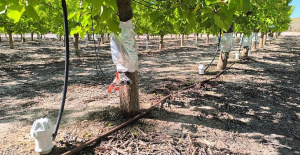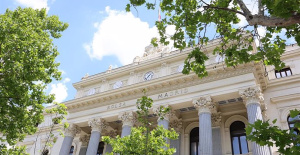Investigators and victims allege that the dominance of the bosses over the gang was such that the crimes could not be committed without their help.
MADRID, 17 Jul. (EUROPA PRESS) -
The National Court (AN) has reopened up to seven cases in recent months, including those related to the kidnapping and murder of the 'popular' councilor Miguel Ángel Blanco or the attack on T4, to investigate the involvement of the ETA executive committees or zubas in them, within the framework of a judicial offensive launched by the victims that seeks to exhaust the criminal responsibility for these crimes beyond their material authors.
This same week the person in charge of the Central Court of Instruction Number 1, Alejandro Abascal, has admitted for processing the complaint filed by Dignity and Justice (DyJ) against four former heads of ETA for the attack perpetrated on September 21, 2008 against a police station in the Ertzaintza in Ondarroa (Vizcaya) with a car bomb, which left no fatalities but did leave 18 injured and extensive material damage.
Specifically, he has agreed to investigate the former ETA leaders Garikoitz Aspiazu Rubina, alias 'Txeroki', for these events; Aitzol Iriondo, 'Gurbitz' or 'Barbas'; Mikel Carrera, 'Ata'; and Ainhoa Ozaeta, 'Kuraia'. For this terrorist attack Asier Badiola and Ibon Iparraguirre have already been sentenced as direct executors.
Central 1 has also dusted off three other cases. At the end of last year, Abascal agreed to reopen the investigations into the attack carried out on December 30, 2006 at Terminal 4 of Madrid's Barajas airport, which cost the lives of two people and caused 41 injuries. At first he did so at the request of the Prosecutor's Office, which asked to continue investigating after a provisional file, although later a DyJ complaint was added.
The investigations were initially directed against 'Txeroki' and Joseba Aranibar, but were later extended to José Antonio Urrutikoetxea, 'Josu Ternera'; 'Ata', 'Gurbitz' and 'Kuraia', who were targeted by the association of victims of terrorism in their complaint. The National Court has already condemned Igor Portu, Mattin Sarasola and Mikel San Sebastián Gaztelumendi as perpetrators.
Abascal is also involved in the investigation into the murder of PP councilor Gregorio Ordóñez, which occurred on January 23, 1995 in San Sebastián. The investigations were resumed in 2015, when the facts were close to statute of limitations, at the request of a complaint filed by Consuelo Ordóñez, sister of the assassinated politician and current president of the Collective of Victims of Terrorism (Covite), to identify and prosecute the 'brains' of this crime.
Intelligence reports then prepared by the Guardia Civil enabled the former head of said court, Santiago Pedraz, to attribute intellectual authorship to Ignacio Miguel Gracia, 'Iñaki de Rentería', and Mikel Albisu, 'Mikel Antza', as well as Julian Achurra Egurola, 'Potato'; Jose Javier Arizcuren Ruiz, 'Songwriter'; and John Louis Aguirre Lete, 'Insuntza'
'Rentería' and 'Antza' testified before Abascal to deny any involvement in the death of Ordóñez, although the other three ETA members mentioned are currently out of reach of the AN, pending France's response to the requested European arrest and surrender orders. to be investigated for these facts. Juan Ramón Carasatorre, 'Jon' and 'Zapata'; Javier García Gaztelu, 'Txapote'; and Valentín Lasarte have already been convicted as perpetrators.
It was last April when Abascal processed another DyJ lawsuit against eight former ETA chiefs for the attack perpetrated by the terrorist organization in 2003 in Sangüesa (Navarra), which took the lives of two police officers.
Here, 'Txeroki', 'Gurbitz', 'Antza', Juan Fernández Iradi, 'Susper'; Gorka Palacios 'Andoni'; Felix Ignacio Esparza 'Gaba'; Ramón Sagarzazu 'Ramontxo'; and María Soledad Iparaguirre 'Anboto', as members of the ETA leadership, and Garikoitz Arruarte and Gorka Lorán as perpetrators of this attack, one of the last committed by ETA, during the 'months of the Titadine'.
The siege of the former top leaders of ETA is also built from two other AN courts. In the Central of Instruction Number 5, Pedraz agreed in December to process another DyJ complaint for the murder of Judge Francisco Querol, which took place on October 30, 2000 in Madrid due to the explosion of a car bomb that killed three other people and injured 30.
Dignidad y Justicia blames the then head of the Madrid Command, Gorka Palacios, as well as 'Rentería', 'Antza', 'Txapote', 'Ramontxo', 'Anboto'; Juan Carlos Iglesias, 'Gaddafi'; Juan Antonio Olarra, 'Jokin'; Ainhoa Mugica, 'Olga'; Asier Oyarzabal, 'Baltza'; and Vicente Goicoechea, 'Willy'.
For its part, the Association of Victims of Terrorism (AVT) has called for the prosecution of the four ETA members who made up the 'Buru Ahuste' commando--Ana Belén Egües, Iván Apaolaza, Juan Luis Rubenach and Gorka Palacios--as perpetrators of this attack.
The head of Central 6, Manuel García Castellón, has reactivated two other cases, also at the request of DyJ. In March, he resumed the investigation into the murder of Miguel Ángel Blanco on July 12, 1997 and, next Thursday, he will interrogate 'Antza' and 'Anboto' as defendants, while he has filed a new OEDE against 'Kantauri' to do your own. 'Txapote' and Irantzu Gallastegui Sodupe, 'Amaia', have already been sentenced as executors.
That same March, the reinforcement magistrate of this court, Joaquín Gadea, reopened the investigations for the attack against the Santa Pola (Alicante) barracks that occurred on August 4, 2002, in which two people died, including a girl. The Civil Guard has already pointed to 'Jokin' and 'Olga' as ETA leaders. Andoni Otegi Eraso, 'Iosu', and Óscar Celarain Ortiz, 'Peio', have already been sentenced as perpetrators.
The legal sources consulted by Europa Press explain that what is allowing the zubas to be persecuted is a new legal path that flees from the traditional figure of intellectual authorship - the one attempted until now -, where it would be required to prove the existence of express orders from ETA leaders to gunmen to commit specific actions, something that presents some difficulty.
Thus, the lawsuits bet on an unexplored path: mediate authorship by domain, where criminal responsibility derives from absolute control of the terrorist organization that makes it impossible for anything to happen without its knowledge; in combination with commission by omission, that is, guilt for not having prevented what could have been prevented.
Where the security forces have already provided their intelligence reports, they describe ETA as "a perfectly structured organization" and with a "strong hierarchy", "where each of its components had a mission, and was subject to the discipline and the orders that the executive committee issued".
"Behind" each "order was the leadership" of ETA, the Civil Guard stated in a recent report on the Miguel Ángel Blanco case. Along the same lines, the judge maintains that the decision to kidnap and kill him could not be made by "a specific or isolated member", but rather had to require the "consensus" of the zuba.
One of the main obstacles to this legal strategy will be the prescription of attacks carried out before 2004, when Spain formally incorporated crimes against humanity into the Penal Code. This deadline problem has already led García Castellón to leave 'Rentería' out of the Miguel Ángel Blanco case. DyJ has asked him to correct, arguing that European conventions make terrorist murders committed since December 24, 1990 imprescriptible: 430 cases.

 Exploring Cardano: Inner Workings and Advantages of this Cryptocurrency
Exploring Cardano: Inner Workings and Advantages of this Cryptocurrency Seville.- Economy.- Innova.- STSA inaugurates its new painting and sealing hangar in San Pablo, for 18 million
Seville.- Economy.- Innova.- STSA inaugurates its new painting and sealing hangar in San Pablo, for 18 million Innova.- More than 300 volunteers join the Andalucía Compromiso Digital network in one month to facilitate access to ICT
Innova.- More than 300 volunteers join the Andalucía Compromiso Digital network in one month to facilitate access to ICT Innova.-AMP.- Ayesa acquires 51% of Sadiel, which will create new technological engineering products and expand markets
Innova.-AMP.- Ayesa acquires 51% of Sadiel, which will create new technological engineering products and expand markets Israel concentrates its attacks in the last few hours on Gaza in the Jabalia displaced persons camp
Israel concentrates its attacks in the last few hours on Gaza in the Jabalia displaced persons camp More than 4,000 people flee several towns in Kharkov due to the new offensive by Russian forces
More than 4,000 people flee several towns in Kharkov due to the new offensive by Russian forces Puigdemont defends the right to vote that he has not been able to exercise since 2017 and hopes to return
Puigdemont defends the right to vote that he has not been able to exercise since 2017 and hopes to return ERC and Junts ask to extend the election day due to the incidence in Rodalies
ERC and Junts ask to extend the election day due to the incidence in Rodalies How Blockchain in being used to shape the future
How Blockchain in being used to shape the future Not just BTC and ETH: Here Are Some More Interesting Coins Worth Focusing on
Not just BTC and ETH: Here Are Some More Interesting Coins Worth Focusing on The CSN finances an IFIC project to evaluate a technology that improves nuclear waste management
The CSN finances an IFIC project to evaluate a technology that improves nuclear waste management Expociència expects to receive more than 4,000 visitors in the Science Park of the University of Valencia
Expociència expects to receive more than 4,000 visitors in the Science Park of the University of Valencia They develop devices for the precise diagnosis of cancer patients
They develop devices for the precise diagnosis of cancer patients UMH researchers are working on a high-quality apricot crop that requires less irrigation water
UMH researchers are working on a high-quality apricot crop that requires less irrigation water A million people demonstrate in France against Macron's pension reform
A million people demonstrate in France against Macron's pension reform Russia launches several missiles against "critical infrastructure" in the city of Zaporizhia
Russia launches several missiles against "critical infrastructure" in the city of Zaporizhia A "procession" remembers the dead of the Calabria shipwreck as bodies continue to wash up on the shore
A "procession" remembers the dead of the Calabria shipwreck as bodies continue to wash up on the shore Prison sentences handed down for three prominent Hong Kong pro-democracy activists
Prison sentences handed down for three prominent Hong Kong pro-democracy activists ETH continues to leave trading platforms, Ethereum balance on exchanges lowest in 3 years
ETH continues to leave trading platforms, Ethereum balance on exchanges lowest in 3 years Investors invest $450 million in Consensys, Ethereum incubator now valued at $7 billion
Investors invest $450 million in Consensys, Ethereum incubator now valued at $7 billion Alchemy Integrates Ethereum L2 Product Starknet to Enhance Web3 Scalability at a Price 100x Lower Than L1 Fees
Alchemy Integrates Ethereum L2 Product Starknet to Enhance Web3 Scalability at a Price 100x Lower Than L1 Fees Mining Report: Bitcoin's Electricity Consumption Declines by 25% in Q1 2022
Mining Report: Bitcoin's Electricity Consumption Declines by 25% in Q1 2022 Oil-to-Bitcoin Mining Firm Crusoe Energy Systems Raised $505 Million
Oil-to-Bitcoin Mining Firm Crusoe Energy Systems Raised $505 Million Microbt reveals the latest Bitcoin mining rigs -- Machines produce up to 126 TH/s with custom 5nm chip design
Microbt reveals the latest Bitcoin mining rigs -- Machines produce up to 126 TH/s with custom 5nm chip design Bitcoin's Mining Difficulty Hits a Lifetime High, With More Than 90% of BTC Supply Issued
Bitcoin's Mining Difficulty Hits a Lifetime High, With More Than 90% of BTC Supply Issued The Biggest Movers are Near, EOS, and RUNE during Friday's Selloff
The Biggest Movers are Near, EOS, and RUNE during Friday's Selloff Global Markets Spooked by a Hawkish Fed and Covid, Stocks and Crypto Gain After Musk Buys Twitter
Global Markets Spooked by a Hawkish Fed and Covid, Stocks and Crypto Gain After Musk Buys Twitter Bitso to offset carbon emissions from the Trading Platform's ERC20, ETH, and BTC Transactions
Bitso to offset carbon emissions from the Trading Platform's ERC20, ETH, and BTC Transactions Draftkings Announces 2022 College Hoops NFT Selection for March Madness
Draftkings Announces 2022 College Hoops NFT Selection for March Madness



























